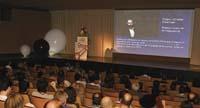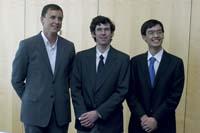Grigori Perelman, mathematician who resigned from the Fields domain

The Russian Grigori Perelman does not want to be a referent of mathematics. In addition, he does not like to speak to the media, he wants to live in peace. That's what he told the English mathematician Sir John Ball when he resigned from the Fields medal.
At that time, in summer 2006, Ball was the leader of the International Mathematical Union (IMU) and, therefore, of the commission designating the winners of the Fields medals. The Commission proclaimed Perelman the winner, but when they informed him, Perelman resigned from the prize. Ball was surprised. However, the commission did not change its opinion.
A problem of the millennium
Perelman's valuable contribution was to find a solution to a problem of more than a hundred years. In 1904, the French mathematician Henri Poincaré proposed a theorem which he did not show. They are not theorems, but conjectures, but when someone finds a proof, then yes, they become theorems. And that's what Perelman did, discovering the mathematical proof of Poincaré's conjecture.
The challenge of Poincaré's conjecture is not (was not) the only one of this kind, but for many experts, the XX. It was the greatest mathematical problem that the twentieth century left unsolved. However, there is a complete list of such problems and the Clay Foundation offers a million US dollars for the mathematician who solves a list problem.

Strict rules. On the one hand, to give the approval to the solution, the Clay Foundation requests that the solution be published in a specialized magazine with a system of referral judges. On the other hand, the solution must last at least two years without cancellation. Perelman's work did not comply with the first norm, since he sent the arXiv to the electronic archive. It is a shop window without judges of the drafts of scientific articles. All the sketches that are sent are not converted into articles, some yes and others no. Perelman's work, for example, no. And so it did not meet the requirements of the prize of a million dollars. But it gives him the same, Perelman had no intention of getting that prize.
Just a draft
In the articles published in the ArXiV file, Perelman did not publish all the details of the conjecture test. It was an article of about 70 pages in which the general ideas and strategies of the test were published. It was a very good draft, but in the end it was a draft. Details were missing.
Other mathematicians tried to complete what was missing. Bruce Kleiner and John Lott published some notes on Perelman's articles (Notes on Perelman's papers). Chinese Huai-Dong Cao and Xi-Ping Zhu published a supposedly exhaustive test ( A Complete Proof of the Poincaré and Geometrization Conjectures ), and in July the American John Mmanifan and the Chinese Gang Tian gave a third job in which the Progresation test has been confirmed.
The titles of the three articles are significant, the first and the third were published with the intention of making new contributions, but the authors of the second, Cao and Zhuk, proposed to have found the definitive proof of the conjecture (partly based on the first article, but not to mention Kleiner and Lott).

The publication dates of the articles were even more significant: They were published in May, June and July 2006. It must be taken into account that the Fields medals were to be delivered in August 2006 at the BWI in Madrid. It is very likely that this summer Cao and Zhuk will have the hope of winning the Fields medal.
However, the committee responsible for distributing the 2006 Fields medals decided to award the prize to Perelman, since in the end it had the merit of the test. Three other winners: Wendelin Werner, Terence Tao and Andrei Okounkov (the three winners). The names of the members of the Commission were kept secret, formed by nine prestigious mathematicians, being the only known member the English John Ball, for being the leader of the organization IMU. So Ball was responsible for talking to Perelman.
No No No No No
John Ball traveled to Saint Petersburg and tried to convince Perelman for two days. In vain. "It was very nice to me," Ball explained in his speech in Bilbao, "but I couldn't change my mind." However, one of the medals of 2006 would be for Perelman.
But after receiving Perelman's refusal and not much later, Ball had a big surprise. Journalists from the weekly New Yorker also spoke to Perelman and prepared an article to publish it before the awards ceremony. The article explained that the Chinese Cao and Zhu wanted to win Perelman's prize with the help of Chinese mathematician Shing Tung Yau, who also had a Fields medal.

Ball asked them to wait at least until the award was given, but those in New York replied no, that they were entitled to publish that journalistic work. However, the article was published on August 28, six days after the awards ceremony of the Fields medals.
Cao and Zhuk did not get the Fields medal, they even had to publish a ratum to publicly recognize that in the article they took advantage of the work of Kleine and Lott.
John Balli, in telling the story, asked him an important question: Is the Perelman test correct? "It is difficult to say, but, while the opposite is not shown, it seems like yes," he said. Ball has no news of Perelman. "He is a great mathematician," he said. "I hope to continue working with mathematics." Yes, surely you will never receive the medal or the money.






